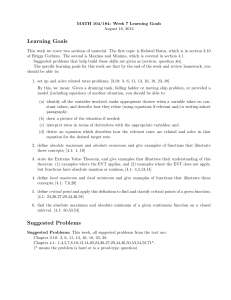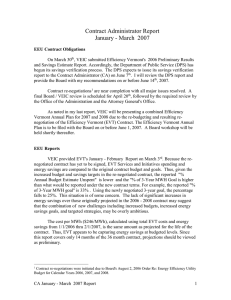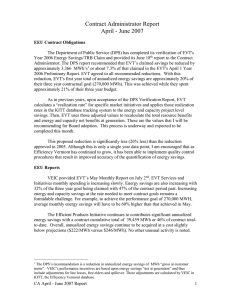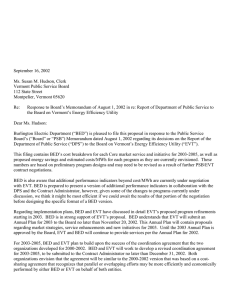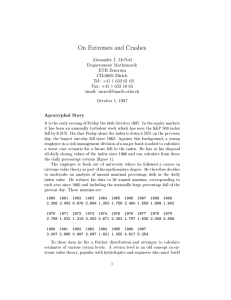Independent Audit of Vermont Energy Efficiency Utility
advertisement
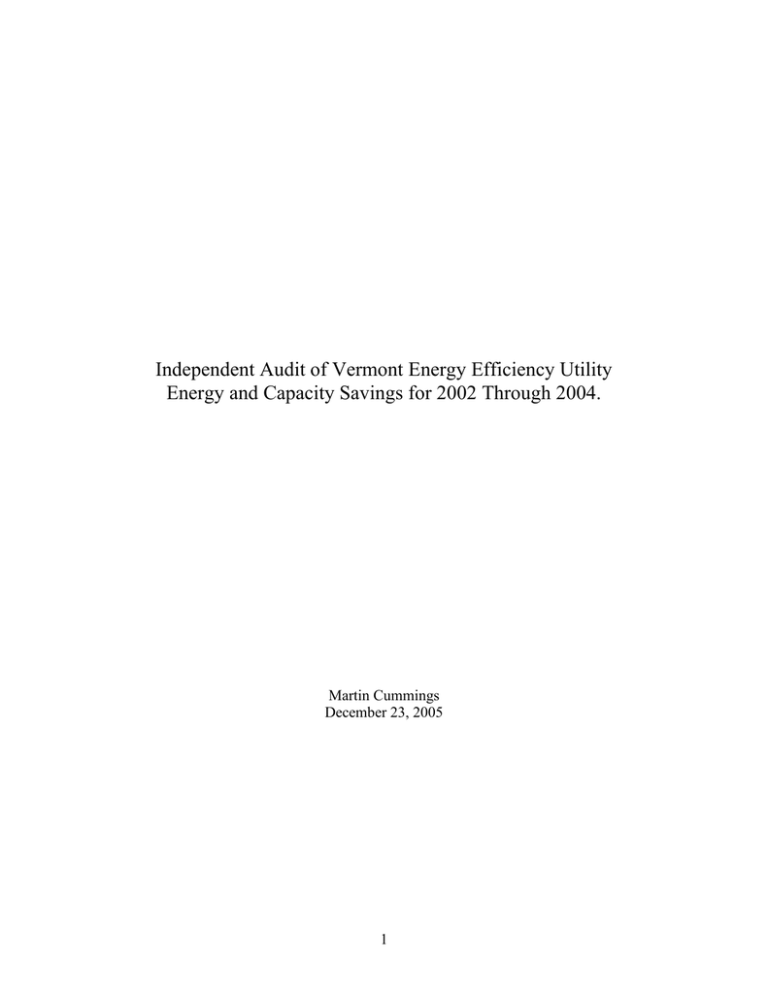
Independent Audit of Vermont Energy Efficiency Utility Energy and Capacity Savings for 2002 Through 2004. Martin Cummings December 23, 2005 1 Table Of Contents Executive Summary Pg. 3 I. Pg. 6 Introduction II. Methods Used to Calculate Energy and Capacity Saving Pg. 7 III. EVT Data Collection and Analysis Procedures Pg. 10 IV. Verification of EVT Annual Report Pg. 14 V. Sources of Engineering Values and Adjustment Factors In the Technical Reference Manual. Pg. 15 VI. Discussion of Individual Program Year Verification Issues and Final Savings Estimates. Pg. 16 VII. Findings Pg. 20 Appendix – Qualifications of the Auditor Pg. 24 2 Executive Summary This audit of Efficiency Vermont (EVT) was undertaken to comply with 30 V.S.A. §209(e)(12), which requires that an independent audit of the energy and capacity savings claims and costeffectiveness of the Energy Efficiency Utility be completed by January 1, 2003 and every three years thereafter. The audit focused on a review of the methods used by EVT to collect data and estimate program energy savings and the methods used by the Department of Public Service to verify EVT’s claimed savings. Because the 2005 program year was still underway at the time of the audit, the audit is limited to a review of program year 2002, 2003 and 2004 data. THE FINDINGS OF THE AUDIT ARE: The EVT estimates of Annual Energy and Capacity Savings, as verified and adjusted by the Department of Public Service, are reliable and unbiased estimates of program savings. During the period 2002 through 2004, the Efficiency Vermont program was directly responsible for the installation of energy efficiency measures that save 135, 953 megawatt hours of electricity each year. Over the 14.3-year average lifetime of these measures, they will save 1,949,897-megawatt hours of electricity. Efficiency Vermont’s programs are highly cost-effective. During the period 2002 through 2004, the EVT programs were cost-effective from the perspective of both the Utility Cost Test and the Societal Cost-Benefit Test. The Utility Cost Test is an analytic tool that is used to compare the cost to the utility of supplying electricity with the cost of providing energy efficiency services. Based on a utility cost test analysis, EVT delivered energy efficiency to Vermonters at a cost of 3.13 cents per kWh. In comparison, the marginal price of electricity purchased by Vermont’s utilities is 6.63 cents per kWh. . Since EVT’s per kWh cost is less than the Vermont electric utilities’ per kWh cost of generation, energy efficiency is a cost effective way to meet system needs Using the Societal Cost-Benefit Test, the benefits of EVT’s programs (including the value of reduced environmental impacts) exceed their costs by 3.66 cents per kWh. Put another way, Vermont receives $1.76 in benefits for every dollar spent on the EVT program. The program returns $1.97 for each dollar spent in the Commercial and Industrial sector and $1.51 for each dollar spent in the Residential sector. The cost-benefit test results are very robust. Based on the high cost-benefit ratios shown in this analysis, the EVT program would remain cost effective even if actual savings were only 57% of estimated savings. 3 VT data collection and analysis procedures are appropriate and include effective quality assurance checks. The Department of Public Service has developed effective procedures for verifying EVT savings estimates. Table 1 summarizes EVT electric energy and capacity savings for 2002, 2003 and 2004. The auditor, based upon his analysis of program cost-effectiveness, has verified these results. Table 1: Cumulative 2002-2004 EVT Program Results Commercial and Industrial Sector Residential Sector Total Programs Electric Energy Savings Annualized MWh 78,414 57,538 135,953 1,258,403 691,494 1,949,897 Winter Peak KW 12,483 9,531 22,015 Summer Peak KW 11,319 6,861 18,180 Lifetime MWh Capacity Savings Total Resource Benefits $63,413,822 $38,669,753 $102,083,575 $0.027 $0.038 $0.031 Net Societal Benefit $0.042 $0.028 $0.037 Benefit to Cost Ratio 1.97 1.51 1.76 Utility Cost Test Cost per KWh Saved Societal Cost Test Annualized megawatt hour (MWh) savings (are those savings that occur in the first year the energy efficiency measures are installed. Lifetime MWh savings are the energy savings expected to accrue over the lifetime of the measures. Capacity is analogous to horsepower. It is the maximum amount of electric power (kW) that can be supplied to Vermont customers at any given instant. If customer demand exceeds system capacity, brownouts or blackouts occur. Capacity savings are reductions in customer demand that improve system reliability and reduce the need for new power plants or purchase power contracts. Capacity savings are particularly important during times of peak demand. 4 The cost per kWh of energy efficiency can be directly compared to an electric utility’s cost of generation. The Utility Cost Test is a commonly used benefit/cost analysis tool, which estimates the annualized cost to the sponsoring utility (in this case EVT) per kilowatt-hour (kWh) of electricity saved by its programs. Since EVT is indirectly funded with ratepayer money, this test reflects the benefits and costs actually received by Vermont ratepayers. The Societal Cost-Benefit Test is a broader measure of program cost-effectiveness. It seeks to summarize and compare all the costs and benefits of the program, regardless of who pays the costs or receives the benefits. Costs included in the test are: EVT’s program costs (including any rebates or incentives paid to participants), performance incentives paid to EVT, participant costs, and third party costs (including Department of Public Service program evaluation costs). Program benefits included in the test are: avoided electric generation costs, avoided electric capacity costs, the environmental benefits of reduced generation, and other incidental resource savings (such as reduced fossil fuel consumption and reduced water usage). The benefit to cost ratio is calculated as the ratio of total program costs to total program benefits under the Societal Cost-Benefit Test. A benefit-cost ratio of more than one indicates that a program is cost-effective. 5 I. Introduction Sections 209(d) and (e) of Title 30, as amended in 1999, gave the Public Service Board (Board or PSB) the authority to establish an Energy Efficiency Utility (EEU). The EEU was intended to improve the delivery of energy efficiency services by replacing the variety of programs offered by the State’s municipal, cooperative and investor owned utilities with a single uniform statewide energy efficiency program. To ensure accountability, the Legislature, in 30 V.S.A. § 209(e) (12), required an independent audit of the energy and capacity savings and cost effectiveness of EEU energy efficiency programs by January 1, 2003, and every three years thereafter. This is the second of the legislatively required independent triennial evaluations of the cost effectiveness of the EEU. In 1999 the Board awarded a contract to the Vermont Energy Investment Corporation (VEIC) to implement the EEU program under the trade name of Efficiency Vermont (EVT). Under VEIC’s contract with the Board, each spring Efficiency Vermont is required to submit a report to the Department of Public Service (DPS, the Department) describing its program accomplishments for the prior year. The DPS, with the assistance of outside consultants, verifies the data and procedures used by EVT to calculate the previous year’s savings estimates, and usually recommends modification of savings estimates. Under the administrative structure established by the PSB, an independent Contract Administrator (CA) reviews the DPS’s recommendations and EVT’s responses to those recommendations, and makes his recommendation to the Board regarding the savings estimates. Then the Board makes a final decision and adopts the EVT savings estimates. In late summer or early fall, EVT submits a final Annual Report that incorporates the revised savings estimates. Martin Cummings undertook the following audit in the last quarter of 2005 under contract to the Vermont Public Service Board. Mr. Cummings has over thirty years of regulatory experience with the New York State Department of Public Service (NYDPS). He is the former Project Director for Program Evaluation for NYDPS Demand Side Management programs and has extensive experience overseeing field audits and program evaluations of electric utility energy efficiency programs. See Appendix A for additional information regarding Mr. Cummings’ qualifications. The audit focused on procedures used by EVT to estimate program savings, and by the Department to verify those savings estimates. The objective of the audit was to determine if these procedures, as designed and implemented, yield reliable and accurate estimates of program savings and cost benefit test results. Audit conclusions are based on a field visit to EVT offices in Burlington, interviews with EVT and DPS staff and the Contract Administrator, the review of over thirty documents, and the responses to numerous E-mail and telephone information requests. Because the 2005 program year was still underway, the scope of the audit was limited to the review of the 2002, 2003 and 2004 program years. 6 Two thousand and two was the final year of VEIC’s initial contract with the PSB. During that year Efficiency Vermont offered nine separate programs targeted to commercial and industrial and residential customers – including programs for new construction, dairy farms, and lowincome customers. In 2002, the Board renewed its contract with VEIC for an additional three years. In 2003, in an effort to improve both program effectiveness and customer service, VEIC radically revised and simplified its program structure. Five “Core Market” service areas replaced the nine programs offered in 2002. This audit will largely focus on the specific end use measures that resulted in the most savings claimed by EVT. While EVT offers financial incentives for a variety of energy efficient technologies, energy efficient lighting measures (both residential and C&I) accounted for over 37% of 2002 through 2004 electricity savings. Improvements in the efficiency of industrial processes and energy efficient motors, accounted for almost 29% of savings. II. Methods Used to Calculate Energy and Capacity Savings It is helpful to think of Efficiency Vermont as providing two different levels of service to its customers. This requires two different levels of sophistication in the estimation of energy and capacity savings. At the simpler level, EVT offers residential and C&I customers rebates for standard offthe-shelf energy efficiency measures – compact florescent light bulbs or energy efficient refrigerators for example. EVT refers to these as “prescriptive measures”. Savings for these measures are estimated using modified engineering estimates. EVT also offers project-specific assistance and incentives for improving the energy efficiency of unique industrial processes, and for complex commercial and industrial new construction projects. EVT refers to these as “custom measures”. Estimating the energy and capacity savings from these projects requires complex project-specific analysis. A. Modified Engineering Estimates EVT’s energy and capacity savings estimates for standard energy efficiency measures are prepared on a measure-by-measure, program-by-program, basis using a method known as the modified engineering estimate. This is a standard method used by energy efficiency programs across the nation. Savings estimates are ordinarily calculated in two forms: gross savings and net savings. Gross savings can be thought of as the energy and capacity savings resulting from installing an energy efficiency measure that an individual customer can expect to see at the meter. 7 Net savings are the adjusted energy and capacity savings, directly resulting from customer participation in an energy efficiency program, which a power company can expect to see at the generator. While gross savings are important to individual customers, net savings are critical for electric system planning and evaluating program cost-effectiveness. In addition, net savings benefit all of a utility’s customers since they allow a utility to purchase less power, the cost of which would have been paid for by all the utility’s ratepayers. The savings reported by EVT and verified by this audit are net savings. Sections A.1 and 2 below briefly review the concepts behind the calculation of gross and net savings from individual measures. Energy efficient compact florescent bulbs (CFLs) are used as an example. 1. Gross Savings Calculations a) Demand Reduction/Capacity Savings (kilowatt or kW) – The calculation of gross savings begins by comparing the electric demand (wattage) of the energy efficient device with the wattage of the less efficient device it will replace. For example, a 29-watt compact florescent bulb produces as much light as a 100-watt incandescent bulb, so replacing the inefficient bulb reduces the customer’s electric demand by 71 watts whenever the lighting fixture is on. From the point of view of an electric system planner, it matters a great deal when the CFLs are on since demand reductions during periods of peak usage can save system capacity, reduce costs and delay the need for constructing new power plants or transmission lines or negotiating new power contracts. Load shape data is used to estimate how much of the demand reduction from the CFLs will fall during on-peak and off-peak time periods. Since the lights in a house are typically turned on and off at different times than the lights in a supermarket or office or school, different load shape estimates are used for different building types. b) Energy Savings (kilowatt hour or kWh) - Annual electric energy savings from a CFL are calculated by multiplying demand savings by an estimate of the number of hours an average bulb is turned on during the course of a year. Like load shapes, estimates of a CFL’s annual hours of use are different for different building types. Thus, a CFL which reduces demand by 71 watts would save about 244 kilowatt hours a year if installed in an office building where the lights are left on for an estimated 3,435 hours a year, but would produce different annual savings in buildings used for other purposes. Lifetime electric energy savings are calculated by multiplying demand savings by the number of hours the CFLs are expected to operate before they burn out – a much longer period than the expected lifetime of an incandescent bulb. Since CFLs that are turned on and off frequently tend to fail somewhat earlier than those that operate more continually, lifetime energy savings also vary by building type. 8 Compact florescent lights also have indirect effects on energy savings. Like all energy efficient measures, CFLs release less waste heat than the inefficient devices they replace. A large building lit solely by florescent lights will require significantly more energy to heat in the winter and less energy to cool in the summer than an identical building lit by incandescent bulbs. 2. Net Savings Adjustments The calculation of net savings incorporates all the factors included in the calculation of gross energy and capacity savings and adds four additional adjustments discussed below. a) Free Rider Adjustment Factor – It is likely that at least a few of the people who participate in energy efficiency programs would have installed efficiency measures even if the programs did not exist. Using our CFL example, assume a homeowner: Learns about the advantages of CFLs in a magazine or from a cable TV show, Makes up his or her mind to try out CFLs based on that information, Walks into a hardware store intending to buy several CFLs, Discovers at the checkout counter that he or she can get a rebate from EVT, and Applies for and receives a rebate. That customer would be considered both a program participant (because he received a rebate) and a free rider (because the rebate had no influence on his purchase decision.) Gross energy and capacity savings estimates are adjusted downward by a free ridership factor that is determined individually for each measure in each program to account for such circumstances. b) Spillover Adjustment Factor– The spillover factor is the converse of the free ridership factor. It accounts for the likelihood that an energy efficiency program is responsible for some purchases of energy efficiency measures that never show up in the program’s tracking system. EVT’s CFL instant rebate program limits rebates to the first six CFLs purchased by a customer each year. Assume a customer: Is motivated by EVT program literature and rebates to buy CFLs, Decides to install CFLs in eight fixtures in his or her house, Purchases eight CFLs at the hardware store, and Receives rebates on six of the eight CFLs he or she purchases. The purchase of the additional two CFLs is an effect of program spillover. The purchases, and the consequent energy and capacity savings, are a direct result of the program, but the unrebated CFLs never show up on the tracking system. Another example of spillover is a customer who intends to participate in a mail-in rebate program, makes the purchase, and then loses the sales receipt or rebate application before he or she can send it in. Gross energy and capacity savings estimates are adjusted upward by a spillover factor that is determined individually for each measure in each program. 9 c) Persistence Adjustment Factor – The persistence factor adjusts for the fact that in some circumstances, anticipated savings may not persist for the normal life of the measure. For example, energy efficient lighting measures have been found to have shorter lifespan in the hostile operating environments of dairy farms. Gross energy and capacity savings estimates are adjusted downwards by a persistence factor that is determined individually for each measure in each program to account for such circumstances. d) Line Loss Factor – The application of free rider and spillover adjustment factors to gross savings estimates produces an estimate of net savings at the customer’s electric meter. However, because of transmission losses, the actual effect of the energy efficiency measures on the electric system is significantly greater. According to data supplied by the DPS, and depending on weather and system load, between 13.5% and 19.9% of the electricity generated at a Vermont power plant, or purchased from an out-of-state supplier, is lost before it reaches Vermont electric utility customers. Gross savings are adjusted upwards by a line loss factor to correct for this effect. 3. The Technical Reference Manual The formulas and values used to calculate gross and net savings using the modified engineering estimate approach are agreed upon in advance by EVT, DPS staff and the Contract Administrator, and are recorded in a lengthy and comprehensive document called the Technical Reference Manual. Section V of this report discusses the sources of the engineering values and gross-to-net adjustment factors in the Technical Reference Manual and the procedures used by EVT and DPS to update the Manual. B. Project Specific Engineering Analysis The predetermined engineering formulas and values in the Technical Reference Manual may not be adequate to estimate savings from complex commercial and industrial retrofit and new construction projects. These projects may involve: Unusual technologies (energy efficient snow making guns, for example); Project-specific applications of relatively common technologies (retrofitting high efficiency motors with adjustable speed drives to an existing industrial process); or The integration of energy efficient technologies and design principals in new buildings. In these cases, energy and capacity savings estimates are based on project specific engineering analyses. These analyses are similar in principle to the modified engineering estimates used to calculate savings from rebated measures, but are more complex and utilize project-specific information provided by customers or collected on-site. III. EVT Data Collection and Analysis Procedures The following section discusses how EVT collects and analyzes energy savings data. EVT has adopted a formal Quality Assurance (QA) program with specific performance targets and milestones. Many aspects of the QA plan are directed towards assuring the 10 integrity of the data and analyses that feed into estimates of energy and capacity savings. Applicable aspects of the QA program are addressed in this section. A. Promoting Energy Efficient Lighting In the Residential Sector Efficiency Vermont has undertaken several initiatives to promote efficient lighting. These include training for architects and builders designing and constructing new homes, incentives to get stores to stock compact florescent bulbs and community wide energy conservation programs. But by far the most important of EVT’s efforts in this area is providing rebates to customers who purchase compact fluorescents or energy efficient fixtures. Since the gross and net energy and capacity savings estimates per energy efficiency measure rebated have been determined in advance, the only data required to estimate total annual savings from this program is the number of valid rebates issued. The primary task is verifying that the rebates have been issued to eligible Vermont customers, and that the limit on number of rebates per customer has not been exceeded. Customers are required to enter their names, addresses, and the name of their electric utility on rebate request forms. EVT enters this information into a database where it is matched to utility account records to verify that the person receiving the rebate is eligible to participate in the program. If a rebate form cannot be computer-matched, it is matched manually. The rebate data are also analyzed to ensure that retail dealers are not violating program limits on the maximum number of instant rebates per participant. The rebate database automatically adds the savings from valid rebates to the tracking system that aggregates total program energy and capacity savings. This eliminates an unnecessary data input step, reducing the opportunity for data entry errors. EVT data input forms are designed to minimize data entry errors by rejecting inputs that fall outside acceptable limits. The company’s QA plan includes data spot checks and quarterly reports on data entry errors. B. Helping Commercial and Industrial Customers Improve the Energy Efficiency of Existing Buildings and Processes Efficiency Vermont attempts to identify commercial and industrial customers at critical moments (e. g.: when they must replace failing or obsolete equipment, or when they plan to remodel or add additional equipment) and intervenes to ensure that they install the most costeffective energy efficient equipment available for that application. The service is primarily marketed through trade allies - the contractors, engineers and equipment vendors likely to be contacted by a commercial or industrial customer when they need to replace or add to equipment. Efficiency Vermont has established working relationships with most of these trade allies and has provided training or information on efficient products. Other leads may come from “cold calls” by EVT staff, referrals from utilities, advertising in trade publications, or direct contacts by customers who have participated in the program in the past. 11 After a lead is received, it is screened by EVT to determine if the customer’s project is a likely candidate for the installation of cost-effective energy efficiency measures. A qualifying lead is assigned to a project manager. In some cases, a trade ally may have already identified opportunities to improve the energy efficiency of the customer’s project; in other cases, EVT technical staff suggest ways to make the project more energy efficient. Some energy efficiency projects are limited to the straightforward installation of measures, such as florescent lighting fixtures with high efficiency electronic ballasts. These are covered by the predetermined engineering formulas and adjustment factors in the Technical Reference Manual. In EVT’s jargon, these are “prescriptive” projects. “Custom” projects - those that involve more complex or unusual measures or applicationsrequire project specific engineering analyses. The initial purpose of these engineering analyses is to determine if energy efficiency improvements are cost-effective. It is frequently the case that energy efficiency improvements that could save money over the long run are not installed by C&I customers because they substantially increase initial costs. To overcome this barrier, EVT may offer the customer a project-specific financial incentive based on the engineering estimate of project savings. All energy and capacity savings estimates are based on a comparison of the energy efficient version of the project to a base case representing the project, as it would have been implemented in the absence of the EVT program. When customers have already prepared initial project plans before they are contacted by EVT, the base case is straightforward. In other cases, equipment vendors are able to provide information on the types of equipment ordinarily included in a “standard bid.” Where these sources of information are not available, the base case is usually assumed to be the minimum code standard. In most cases, the EVT project manager, or technical staff under his/her direction, prepares the engineering estimate of savings. In other cases, the trade ally who referred the customer staff prepares initial savings estimates that are subsequently reviewed and approved by EVT technical staff. EVT uses industry standard engineering analysis software for thermal modeling, heating and air conditioning sizing, lighting design and some other aspects of the engineering estimate of project savings. The project managers and technical staff appear to have adequate professional training and experience to perform these analyses. Many of the project managers are electrical or mechanical engineers who are members of professional societies. Many are certified as Energy Managers by the Association of Energy Engineers. All technical staff working on commercial and industrial projects have been trained in the Vermont Commercial Construction Energy Guidelines and engineering analysis software. EVT uses data input forms for the engineering analysis software. These forms reduce data entry errors by refusing to accept inputs that fall outside of the feasible range for each item. The engineering analysis software is integrated with EVT’s tracking system to permit automatic transfer of information to the database that generates annual savings estimates. This integration reduces the opportunity for data entry errors. 12 EVT inspects nearly all “custom” projects and all “prescriptive” projects that receive incentives greater than $2500. Once EVT has verified that the project has been completed and meets agreed upon standards, the energy and capacity savings estimates developed by the project-specific engineering analysis are included in that year’s estimate of program savings. The Quality Assurance plan calls for a sample of the initial project screening analyses and project-specific engineering analyses to be cross-checked and verified by a “third party” - a qualified EVT staff member who has not been directly involved in that project. A sample of completed projects is also field-inspected a second time by a “third party” EVT staff member. C. Helping Commercial and Industrial Customers Construct More Efficient New Buildings Efficiency Vermont attempts to intervene between the decision to construct a new commercial and industrial building, and the final project design .by providing technical advice and engineering analysis for thermal envelope measures (insulation, efficient windows, etc.) and building design features (day lighting and passive solar heating, etc.). Depending on the size of the project, its potential for energy savings, and the stage the project has reached in the design process, EVT may pay for the additional architectural or engineering design work needed to improve building efficiency and/or, provide incentives for the installation of specific energy efficiency measures. Although this service is marketed through trade allies, EVT develops many leads by monitoring the Dodge Report (a trade publication that reports on planned construction projects), other general, and trade publications, and Act 250 records for project announcements. In general the base case for calculating energy savings is derived from architectural plans developed before EVT became involved in the project, from building codes, or by determining the “standard industry practice” for constructing buildings of a particular type. Projects subject to Act 250 are treated somewhat differently. Act 250 requires that projects be built to higher standards of energy efficiency than non-Act 250 projects, but does not define those standards in great detail. Based on its experience administering Act 250 energy efficiency standards, the Department of Public Service has developed a baseline construction standard that represents the level of energy efficiency improvements (above industry standards) commonly required of projects approved under Act 250. EVT is allowed to claim energy and capacity savings on only those measures or design features that exceed this baseline. D. Preparation of Initial Annual Report The EVT program year ends on December 31. Early in the following year, EVT: (1) completes the entry of data from rebated measures installed during the prior year, and the calculation of savings and data entry from custom measures and new construction projects completed during the prior year, (2) calculates aggregate program savings, and (3) prepares an initial annual report for submission to the Department of Public Service. 13 IV. Verification of EVT Annual Report A. Department of Public Service Verification Activities The Department’s technical review and verification activities are conducted by experienced professional staff supplemented by West Hill Energy and Computing (West Hill) an outside engineering contractor. The DPS review takes several months. 1. Review of EVT Database. West Hill reviews the EVT database files that generate savings estimates for rebated measures to insure that the formulas, engineering values and gross-to-net adjustment factors were consistent with the Technical Review Manual. 2. Identification of Savings Estimate Issues Affecting Residential Projects - Based on the database review West Hill identifies a number of measurement issues which could affect EVT’s estimates of savings from residential sector programs. 3. Identification of a Sample of C&I Projects for Review – West Hill also identifies specific Commercial and Industrial projects for detailed review. The procedure for identifying the projects for review, and the way the data on reviewed projects is applied have changed significantly during the three years covered by this report. From the inception of the program in 2000 through the 2003 program year, West Hill would select for detailed review the largest projects from each Commercial and Industrial program and additional smaller projects which featured unusual conservation measures. If West Hill’s detailed review found errors in savings estimates for a specific project it would recommend a savings adjustment, for that specific project, to the DPS staff. In 2005, West Hill developed a more sophisticated statistically-based procedure for selecting projects for review. This revised procedure is described in Section VII C., the discussion of 2004 program year verification issues and results. 4. Issue Resolution – In spring or early summer, the DPS provides EVT with an extensive list of issues to be resolved. Many of the issues concerned the calculation of EVT savings for specific large C&I projects, or the calculation of savings for complicated or unusual energy efficiency measures in the commercial and industrial sector; others concerned savings from residential programs. In most cases the DPS proposed specific reductions in energy and capacity savings for the projects or measures under review. Over the following month the Department conducted further analysis and met with EVT staff and the Contract Administrator in an attempt to resolve verification issues. In some cases, EVT agreed that the Department’s concerns are valid and voluntarily accepts reductions in claimed energy and capacity savings. In other cases EVT was able to satisfy DPS concerns. 14 B. Role of the Contract Administrator As required by the PSB, the Department reports to the Contract Administrator in spring or early summer on its review of EVT’s savings estimates for the prior year. The report describes the steps the DPS took to verify savings, the issues raised during the verification process, and the Department’s proposed adjustments to EVT’s claimed savings. The Contract Administrator resolves any remaining disputes between the Department and EVT at the conclusion of the Department’s verification process, and recommends final savings numbers to the Board. C. Final Efficiency Vermont Annual Report In late summer or fall, EVT issues a revised annual report for the previous year which includes the savings adjustments recommended by the Department and approved by the Contract Administrator, and estimates of program cost effectiveness. V. Sources of Engineering Values and Adjustment Factors in the Technical Reference Manual The accuracy of the EVT savings estimates is, in the end, dependent on the validity of the hundreds of engineering values and adjustment factors contained in the Technical Reference Manual (TRM). It is therefore important to review the original source of this information and the procedures used by EVT, the DPS, and the Contract Administrator to update and refine it. A. Initial Source of Technical Reference Manual Data Most of the engineering values and adjustment factors in the initial (2000) version of the Technical Reference Manual (TRM), were derived from “The Power to Save: A Plan to Transform Vermont’s Energy-Efficiency Markets”, a feasibility study for the statewide energy efficiency utility. This report, issued by the Vermont Department of Public Service in May of 1997, included analyses of the potential energy and capacity savings from a variety of energy efficiency programs and technologies. The data and assumptions underlying these analyses, including engineering values and adjustment factors, are contained in appendix 3 of “The Power to Save” and associated work papers. Optimal Energy, the consulting firm that prepared this section of the report, specializes in energy efficiency programs and has conducted similar studies in several states in the Northeast. The engineering values and adjustment factors underlying its analysis were primarily derived from manufacturer specifications and from studies conducted by Vermont utilities and energy efficiency programs in other states. Annotations and footnotes in the TRM cite the sources for many, but not all, of the engineering values and adjustment factors. B. Updating the Technical Reference Manual The Technical Reference Manual has been frequently updated to add data on measures not covered in “The Power to Save” and to revise existing data as programs change or new data becomes available. Efficiency Vermont maintains a master copy of the TRM that records all 15 changes in formulas, engineering values, and adjustment factors. The reasons for many, but not all, of these changes are briefly noted in the TRM. Each year EVT provides the Department, the Board and the Contract Administrator with an updated version of the TRM. Either EVT or DPS staff may initiate proposed revisions to the TRM. The Technical Advisory Group (TAG), comprised of staff from both EVT and DPS, reviews all proposed changes. The Contract Administrator chairs the TAG. If the group is unable to resolve an issue, EVT modifies the TRM to reflect its current practice. The DPS may propose modifications of those savings estimates in the annual verification process. C. Program Evaluations Many of the engineering values (hours of use, load shapes, etc.) and adjustment factors (free ridership, spillover, etc.) in the TRM were initially based on impact evaluations undertaken by utilities or government agencies in other states. While methodologies vary, it is typical for such impact evaluations to be based on: mail or telephone surveys of a statistically valid sample of participants and non-participants; statistical analysis of participant and nonparticipant bills; or, end use metering. Because climate, program design and market characteristics vary from state to state, extrapolation of impact evaluation data collected outside of Vermont requires careful analysis and professional judgment. Because many types of program evaluations are not feasible until a program has been running for several years, the Department undertook relatively little program evaluation work during the first several years of the Efficiency Vermont program. However, in 2003 the Department hired Nexus Market Research and RLW Analytics to perform a two-phase program evaluation of the EVT efficient residential lighting program. This study, which was completed in time to effect program year 2004 savings estimates, is discussed in section VI.C below. VI. Discussion of Individual Program Year Verification Issues and Final Savings Estimates. This section of the report briefly summarizes the major savings verification issues that arose each year during the Department of Public Service and Contract Administrator review and verification of EVT’s claimed savings for the year, explains how these issues were resolved and presents the final, verified, program results for the year. A. Program Year 2002 The issues that arose during the DPS review and verification of EVT’s claimed 2002 program year savings were relatively minor and included: A reduction of assumed average hours of use for energy efficient lighting fixtures in new homes; A modification of free rider rates for space and hot water fuel switching; An adjustment for potential double counting of savings when electric water and space heat customers first install conservation measures provided by EVT (water heater 16 wraps for example) and later use another EVT program to switch from electric water or space heating systems to oil or gas fired systems; and, Adjustments in savings estimates for 15 specific Commercial and Industrial retrofit or new construction projects based on West Hills intensive review of 26 projects. EVT agreed to all of the proposed DPS changes. In aggregate, these changes resulted in only a 3% reduction in the MWh savings originally claimed by EVT and corresponding changes in estimated capacity reductions and total resource benefits. Efficiency Vermont’s final verified results for 2002 are shown in table 2. Table 2: Program Year 2002 Commercial and Industrial Sector Residential Sector Total Programs Electric Energy Savings Annualized MWh 18,436 19,927 38,363 Lifetime MWh 288,803 263,902 552,705 Winter Peak kW 3,915 3,300 7,215 Summer Peak kW 2,460 2,285 4,745 $13,131,255 $11,999,059 $25,130,314 Capacity Savings Total Resource Benefits B. Program Year 2003 The major savings verification issue that arose with regards to the 2003 program concerned the average number of hours a day that the typical compact florescent light (CFL) bulb is turned on in a residential setting. On a lumen per lumen basis, compact fluorescents require only about a third of the energy of incandescent bulbs. They also last much longer than incandescent bulbs. But even after receiving a rebate the initial cost of a CFL is significantly higher than a standard light bulb. It is logical to assume that a savvy first time buyer of one or two CFL’s would maximize his savings by installing the bulbs in the lighting fixtures (kitchen ceiling lights or a frequently used hallway) that are turned on for the longest period during the average day. Based on this assumption and studies conducted in other states, EVT and DPS agreed in 2000 to use an estimate that, on average, CFLs purchased through the EVT rebate program were switched on an average of 3.4 hours a day. 17 Over the first four years of its program Efficiency Vermont’s efforts to popularize CFLs were highly successful. CFLs became available in many more stores. Prices and (rebate levels) dropped, and many more Vermonter’s were familiar with the technology. Evidence from a variety of sources, including EVT’s rebate records showed that customers were, on average, buying many more CFLs than in the early days of the program. The DPS argued in its review of the 2003 program that EVT’s very success in popularizing CFLs was probably resulting in a decline in the average number of hours a day that they were turned on. After all, if a customer had seven or eight CFLs installed in his house it was likely that some were in locations (a spare bedroom or basement for example) where they were used far less than 3.4 hours a day. Accordingly, DPS recommended that the average number of daily hours of use for CFLs be reduced to 2.9 hours a day. DPS recognized the need for more definitive information on savings from this important end use and, in combination with four energy conservation programs in Massachusetts and Rhode Island entered into a contract with Nexus Market Research and RLW Analytics to do a detailed study of the energy and capacity savings resulting from residential lighting programs. This study was completed in the fall of 2004 and is summarized in the discussion, below, of 2004 year program results. The Department also recommended, based on West Hill's review of selected projects, that savings estimates be adjusted for nine commercial and industrial projects. Overall, the DPS recommended a 6.2 % reduction in MWh savings claimed by EVT. Efficiency Vermont’s final verified results for 2003 are shown in Table 3. Table 3: Program Year 2003 Commercial and Residential Industrial Sector Sector Total Programs Electric Energy Savings Annualized MWh 31,677 14,997 46,675 488,066 205,290 693,356 Winter Peak kW 4,916 2,634 7,550 Summer Peak kW 4,214 1,774 5,988 $28,847,145 $13,139,897 $41,987,042 Lifetime MWh Capacity Savings Total Resource Benefits C. Program Year 2004 1. Lighting Program Evaluation - In 2004 Nexus Market Research and RLW Analytics undertook a program evaluation of energy efficient residential lighting rebate programs in 18 Massachusetts, Rhode Island and Vermont. This information was received too late to affect savings estimated from the 2003 program year, but was used by EVT and DPS in estimating savings from the 2004 program year. As part of their evaluation Nexus and RLW: Conducted telephone surveys with 823 customers who had purchased energy efficient lighting products during 2003 through one of energy conservation programs included in the study: Visited the homes of 128 participating customers where the researchers administered a more detailed survey, observed the number of efficient lighting measures currently in place and installed lighting loggers to measure how many hours a day that the CFL’s and efficient fixtures were actually turned on, and, Performed an engineering assessment of the actual service lifetimes of the various lighting products. Based on this study, the consultant concluded that on average CFL’s were left on for 3.2 hours a day. This is significantly higher than the 2.9 hours a day used in estimating savings from the 2003 program year and suggests that the verified savings estimates for that year may be somewhat lower than actual savings. The study also found that the free ridership rate for CFL’s was only about 6% and that a large number of people who bought their first CFL because of rebates offered by EVT later bought additional CFL’s without applying for additional rebates. Similar data was collected for other types of energy efficient lighting products in the EVT program. 2. Statistical Sampling of Commercial and Industrial Projects – Beginning with the 2004 Program Year, the Department significantly revised and improved the process it uses to verify savings from Commercial and Industrial retrofit and new construction projects. West Hill, the Department’s engineering consultant still reviews all of the largest commercial and industrial projects (seven in 2004). It then sorts all the remaining projects into size stratified “bins” and randomly selects a sample of projects (80 in all) to review from each bin. Based on the results of its review of these randomly chosen projects West Hill calculates a “realization rate” which is then applied to all of the projects in each bin. This procedure is more comprehensive and unbiased than the former method of adjusting savings from C&I projects on a case-by-case basis. In its review of the 2004 program year, West Hill discovered a serious mistake in EVT’s engineering analysis that essentially wiped out the savings from one of the year’s largest projects. Based on the analysis of a statistical sample of other sizes and types of projects, West Hill recommended that EVT’s estimate of savings from Commercial and Industrial retrofit projects be reduced by about 4% and that estimates of savings from C&I new construction projects be reduced by about 15%. Overall the Department recommended that EVT’s estimates of MWh savings for the 2004 program year be reduced by 12.1 %. 19 Efficiency Vermont’s final verified results for 2004 are shown in table 4. Table 4: Program Year 2004 Commercial and Industrial Sector Residential Sector Total Programs Electric Energy Savings Annualized MWh 28,301 22,614 50,915 481,534 222,302 703,836 Winter Peak kW 3,652 3,597 7,250 Summer Peak kW 4,645 2,802 7,447 $21,435,422 $13,530,797 $34,966,219 Lifetime MWh Capacity Savings Total Resource Benefits VII. Findings A. The Use of Modified Engineering Estimates is an Appropriate Method for Calculating Program Energy and Capacity Savings The use of modified engineering estimates to calculate gross and net program energy and capacity savings is a standard technique commonly used by energy efficiency programs nationwide. The basic formulas and adjustment factors (free riders, spillover) used by EVT in the Technical Reference Manual are consistent with industry practice. B. Efficiency Vermont’s Data Collection and Analysis Procedures are Appropriate and Include Adequate Quality Assurance Checks Based on the auditor’s review of EVT documents and interviews with EVT staff, the EVT staff who collect and analyze energy efficiency data have appropriate training and experience. EVT data input forms, engineering analysis programs, and tracking systems are designed and integrated to minimize data entry errors. EVT has also developed and implemented a quality assurance program, much of which is directed towards ensuring the accuracy of engineering estimates of savings. C. Department of Public Service Staff and the Contract Administrator Have Developed Appropriate Procedures for Verifying EVT Savings Estimates and Have Implemented These Procedures Diligently. 20 The DPS has developed detailed and effective procedures for verifying and, if necessary, adjusting EVT’s savings estimates and has obtained the specialized consulting services necessary to assist it in the implementation of the verification process. The Contract Administrator has been effective in managing the verification process and resolving disputes between EVT and the DPS. D. Although the Source of the Engineering Values and Adjustment Factors in the TRM Is Not Completely Documented, the Values That Are Documented Appear to be Reliable and Unbiased. The sources of many, but not all, of the hundreds of engineering values and adjustment factors in the TRM are documented by annotations or footnotes in the TRM. Those that are documented appear to have been derived from appropriate sources. The contractor that developed the original values for “The Power to Save” had considerable experience in the field of energy efficiency and there is no reason to believe that the undocumented values are inaccurate or come from inappropriate sources. It is likely that EVT or the Department, in the course of preparing and verifying savings estimates, would have picked up any significant errors in major measures. E. The EVT Estimates of Annual Energy and Capacity Savings, as Verified and Adjusted by the Department of Public Service, are Reliable and Unbiased Estimates of Program Savings. Because the calculation of program savings from the EVT energy efficiency program is necessarily dependent on a large number of engineering values and adjustment factors, some of which cannot be known with certainty, savings estimates must be recognized as just that – estimates. The audit has shown that EVT and the Department have put into place appropriate procedures and controls to minimize sources of error and bias in the estimation process. Accordingly, the savings estimates in the adjusted EVT annual reports should be considered reliable and unbiased estimates of actual program savings. F. During the period 2002 through 2004, the EVT Program was Cost-Effective From the Perspective of the Utility Cost Test. Using these savings estimates and EVT program expenditure data, the auditor calculated Utility Cost Test results for the 2002 – 2004 EVT program. The Utility Cost Test is a commonly used benefit/cost analysis tool, which estimates the annualized cost to the sponsoring utility per kWh of electricity saved by its programs. The inputs to the test are the annualized MWh savings from EVT programs, EVT’s actual program expenditures, and the average lifetime of the energy efficiency measures installed. Because the program is funded by ratepayers through a System Benefit Charge, the utility test quantifies state ratepayer revenue requirements rather than utility investment. 21 Table 5 shows Utility Cost Test results for EVT’s program as a whole, and separately for the Commercial and Industrial and Residential market segments. Table 5: Utility Cost Test Results Annualized Cost per kWh Saved Commercial and Industrial Sector $0.027 Residential Sector $0.038 Total Program $0.031 It is instructive to compare the costs of electricity saved through energy efficiency to the current cost of electricity in Vermont. Average retail electric rates in Vermont are: o $0.1139 for commercial customers; o $0.0800 for industrial customers; and o $0.1302. for residential customers. The marginal cost of the electricity purchased by Vermont utilities is $0.0554 per kWh, Vermont utilities have an average transmission and distribution cost of $0.0119, which, when added to the purchase price of power, brings the cost of a kWh of electricity to the utility to $0.0663, about twice the cost of energy efficiency. G. During the period 2002 through 2004, the EVT Program was Cost-Effective From the Perspective of the Societal Cost-Benefit Test. The Societal Cost-Benefit Test is a broader measure of program cost-effectiveness. It seeks to summarize and compare all the costs and benefits of the program, regardless of who pays the costs or receives the benefits. The following costs are included in the test: EVT’s program costs - including any rebates or incentives paid to participants and performance incentives paid to EVT; Participant and Third Party Costs – mainly the measure costs above EVT rebates that were paid by participants. Administrative Costs– including DPS’s verification costs and the cost of the Contract Administrator. The following program benefits are included in the test: Resource Benefits - The great majority of the resource benefits from EVT programs come from electric energy and capacity savings. Resource benefits also include the net effects on oil and other fossil fuel consumption of improving building insulation and of switching customers from electric space and water heating to other fuels. Decreases in water consumption from energy efficient washing machines, etc. are also included in resource benefits. Environmental benefits of reduced generation 22 Table 6 shows Societal Cost Test results for EVT’s program as a whole, and separately for the Commercial and Industrial and Residential market segments. Table 6: 2002-2004 Societal Cost Test Inputs and Results C&I Sector KWh savings EVT Costs Participant and Third Party Costs Administrative costs (DPS,CA,FA) Total Costs (adjusted for risk*) Resource Benefits (Lifetime) Environmental Benefits ($0.007 kWh) Total Benefits Societal Benefit $/kWh Benefit /Cost Ratio Residential Sector All Programs 78,414,000 57,538,000 135,952,000 $20,356,166 $ 15,046,262 $757,000 $17,807,891 $10,207,178 $757,000 $38,164,057 25,253,440 $ 1,514,000 $32,543,493 $25,894,854 $58,438,347 $63,428,822 $548,898 $38,669,753 $402,766 $102,098,575 $951,664 $63,977,720 $39,072,519 $103,050,239 $0.042 $0.028 $0.037 1.97 1.51 1.76 Test results are shown in two formats. Societal benefits $/kWh expresses the test results as net social benefits per kWh of electricity conserved as a result of EVT programs. The societal benefit/cost ratio compares the costs of the program to Vermonters to the benefits they receive. Overall, Vermont receives $1.71 in benefits for every dollar spent on the EVT program. The cost effectiveness of Commercial & Industrial sector programs is particularly high. Vermont receives $2.09 in benefits for each dollar it spends on C&I energy efficiency programs Most of those benefits are in the form of reduced energy costs for Vermont businesses. This test does not attempt to compute the increased employment or economic activity that results from reducing the energy costs of Vermont businesses These are very robust cost-benefit test results. Finding E noted that program savings are based on engineering estimates that, no matter how carefully applied, may differ slightly from actual savings. Based on the high cost-benefit ratios shown in this analysis, the EVT programs would be cost effective even if actual savings were only 57% of estimated savings. Clearly, the EVT engineering estimates are far more accurate than that. There can be no doubt that, even allowing for a reasonable level of uncertainty; the Efficiency Vermont program is highly cost effective. * For a variety of reasons, generation and transmission facilities may be subject to unplanned outages and capacity reductions. A 10% risk adjustment factor was adopted by the PSB in Docket 5270 to account for the reduced risk associated with energy efficiency. 23
